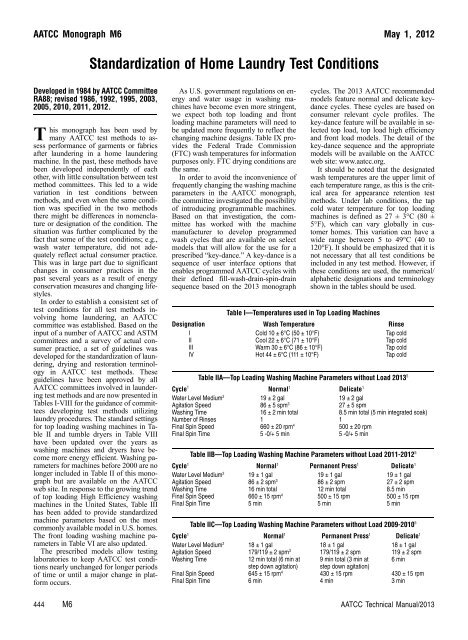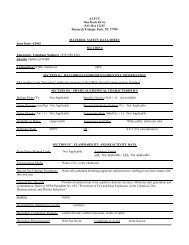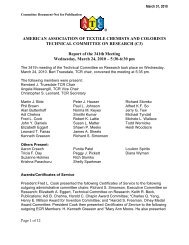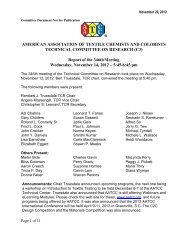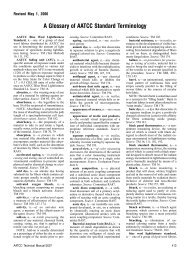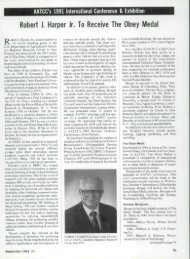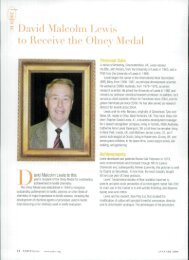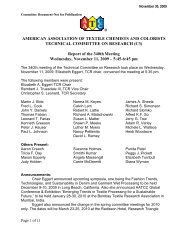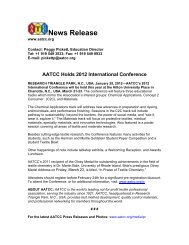Standardization of Home Laundry Test Conditions
Standardization of Home Laundry Test Conditions
Standardization of Home Laundry Test Conditions
Create successful ePaper yourself
Turn your PDF publications into a flip-book with our unique Google optimized e-Paper software.
AATCC Monograph M6 May 1, 2012<br />
Developed in 1984 by AATCC Committee<br />
RA88; revised 1986, 1992, 1995, 2003,<br />
2005, 2010, 2011, 2012.<br />
T<br />
<strong>Standardization</strong> <strong>of</strong> <strong>Home</strong> <strong>Laundry</strong> <strong>Test</strong> <strong>Conditions</strong><br />
his monograph has been used by<br />
many AATCC test methods to assess<br />
performance <strong>of</strong> garments or fabrics<br />
after laundering in a home laundering<br />
machine. In the past, these methods have<br />
been developed independently <strong>of</strong> each<br />
other, with little consultation between test<br />
method committees. This led to a wide<br />
variation in test conditions between<br />
methods, and even when the same condition<br />
was specified in the two methods<br />
there might be differences in nomenclature<br />
or designation <strong>of</strong> the condition. The<br />
situation was further complicated by the<br />
fact that some <strong>of</strong> the test conditions; e.g.,<br />
wash water temperature, did not adequately<br />
reflect actual consumer practice.<br />
This was in large part due to significant<br />
changes in consumer practices in the<br />
past several years as a result <strong>of</strong> energy<br />
conservation measures and changing lifestyles.<br />
In order to establish a consistent set <strong>of</strong><br />
test conditions for all test methods involving<br />
home laundering, an AATCC<br />
committee was established. Based on the<br />
input <strong>of</strong> a number <strong>of</strong> AATCC and ASTM<br />
committees and a survey <strong>of</strong> actual consumer<br />
practice, a set <strong>of</strong> guidelines was<br />
developed for the standardization <strong>of</strong> laundering,<br />
drying and restoration terminology<br />
in AATCC test methods. These<br />
guidelines have been approved by all<br />
AATCC committees involved in laundering<br />
test methods and are now presented in<br />
Tables I-VIII for the guidance <strong>of</strong> committees<br />
developing test methods utilizing<br />
laundry procedures. The standard settings<br />
for top loading washing machines in Table<br />
II and tumble dryers in Table VIII<br />
have been updated over the years as<br />
washing machines and dryers have become<br />
more energy efficient. Washing parameters<br />
for machines before 2000 are no<br />
longer included in Table II <strong>of</strong> this monograph<br />
but are available on the AATCC<br />
web site. In response to the growing trend<br />
<strong>of</strong> top loading High Efficiency washing<br />
machines in the United States, Table III<br />
has been added to provide standardized<br />
machine parameters based on the most<br />
commonly available model in U.S. homes.<br />
The front loading washing machine parameters<br />
in Table VI are also updated.<br />
The prescribed models allow testing<br />
laboratories to keep AATCC test conditions<br />
nearly unchanged for longer periods<br />
<strong>of</strong> time or until a major change in platform<br />
occurs.<br />
As U.S. government regulations on energy<br />
and water usage in washing machines<br />
have become even more stringent,<br />
we expect both top loading and front<br />
loading machine parameters will need to<br />
be updated more frequently to reflect the<br />
changing machine designs. Table IX provides<br />
the Federal Trade Commission<br />
(FTC) wash temperatures for information<br />
purposes only. FTC drying conditions are<br />
the same.<br />
In order to avoid the inconvenience <strong>of</strong><br />
frequently changing the washing machine<br />
parameters in the AATCC monograph,<br />
the committee investigated the possibility<br />
<strong>of</strong> introducing programmable machines.<br />
Based on that investigation, the committee<br />
has worked with the machine<br />
manufacturer to develop programmed<br />
wash cycles that are available on select<br />
models that will allow for the use for a<br />
prescribed “key-dance.” A key-dance is a<br />
sequence <strong>of</strong> user interface options that<br />
enables programmed AATCC cycles with<br />
their defined fill-wash-drain-spin-drain<br />
sequence based on the 2013 monograph<br />
cycles. The 2013 AATCC recommended<br />
models feature normal and delicate keydance<br />
cycles. These cycles are based on<br />
consumer relevant cycle pr<strong>of</strong>iles. The<br />
key-dance feature will be available in selected<br />
top load, top load high efficiency<br />
and front load models. The detail <strong>of</strong> the<br />
key-dance sequence and the appropriate<br />
models will be available on the AATCC<br />
web site: www.aatcc.org.<br />
It should be noted that the designated<br />
wash temperatures are the upper limit <strong>of</strong><br />
each temperature range, as this is the critical<br />
area for appearance retention test<br />
methods. Under lab conditions, the tap<br />
cold water temperature for top loading<br />
machines is defined as 27 ± 3°C (80 ±<br />
5°F), which can vary globally in customer<br />
homes. This variation can have a<br />
wide range between 5 to 49°C (40 to<br />
120°F). It should be emphasized that it is<br />
not necessary that all test conditions be<br />
included in any test method. However, if<br />
these conditions are used, the numerical/<br />
alphabetic designations and terminology<br />
shown in the tables should be used.<br />
Table I—Temperatures used in Top Loading Machines<br />
Designation Wash Temperature Rinse<br />
I Cold 10 ± 6°C (50 ± 10°F) Tap cold<br />
II Cool 22 ± 6°C (71 ± 10°F) Tap cold<br />
III Warm 30 ± 6°C (86 ± 10°F) Tap cold<br />
IV Hot 44 ± 6°C (111 ± 10°F) Tap cold<br />
Table IIA—Top Loading Washing Machine Parameters without Load 2013 5<br />
Cycle 1<br />
Normal1 Delicate1 Water Level Medium2 19 ± 2 gal 19 ± 2 gal<br />
Agitation Speed 86 ± 5 spm3 27 ± 5 spm<br />
Washing Time 16 ± 2 min total 8.5 min total (5 min integrated soak)<br />
Number <strong>of</strong> Rinses 1 1<br />
Final Spin Speed 660 ± 20 rpm4 500 ± 20 rpm<br />
Final Spin Time 5 -0/+ 5 min 5 -0/+ 5 min<br />
Table IIB—Top Loading Washing Machine Parameters without Load 2011-2012 5<br />
Cycle 1 Normal 1 Permanent Press 1 Delicate 1<br />
Water Level Medium 2 19 ± 1 gal 19 ± 1 gal 19 ± 1 gal<br />
Agitation Speed 86 ± 2 spm 3 86 ± 2 spm 27 ± 2 spm<br />
Washing Time 16 min total 12 min total 8.5 min<br />
Final Spin Speed 660 ± 15 rpm 4 500 ± 15 rpm 500 ± 15 rpm<br />
Final Spin Time 5 min 5 min 5 min<br />
Table IIC—Top Loading Washing Machine Parameters without Load 2009-2010 5<br />
Cycle 1 Normal 1 Permanent Press 1 Delicate 1<br />
Water Level Medium 2 18 ± 1 gal 18 ± 1 gal 18 ± 1 gal<br />
Agitation Speed 179/119 ± 2 spm3 179/119 ± 2 spm 119 ± 2 spm<br />
Washing Time 12 min total (6 min at 9 min total (3 min at 6 min<br />
step down agitation) step down agitation)<br />
Final Spin Speed 645 ± 15 rpm4 430 ± 15 rpm 430 ± 15 rpm<br />
Final Spin Time 6 min 4 min 3 min<br />
444 M6 AATCC Technical Manual/2013
Table IID—Top Loading Washing Machine Parameters without Load 2000-2008<br />
Cycle 1 Normal 1 Permanent Press 1 Delicate 1<br />
Water Level Medium 2 18 ± 1 gal 18 ± 1 gal 18 ± 1 gal<br />
Agitation Speed 179 ± 2 spm 3 179 ± 2 spm 119 ± 2 spm<br />
Washing Time 12 min 10 min 8 min<br />
Final Spin Speed 645 ± 15 rpm 4 430 ± 15 rpm 430 ± 15 rpm<br />
Final Spin Time 6 min 4 min 6 min<br />
1 Cycle names vary with machine brand and model. “Normal Cycle” generally corresponds to the cycle that has the<br />
highest agitation and spin speed and it is also frequently designated as “Heavy Duty” or “Ultra Clean.” “Permanent<br />
Press Cycle” generally corresponds to the cycle with the shortest final spin time to minimize wrinkle formation<br />
and it is also frequently designated as “Easy Care.” “Delicate Cycle” generally corresponds to the cycle with<br />
the shortest washing time and it is also frequently designated as “Gentle.”<br />
2 This is the water volume designated for washing medium sized loads also referred to as a “medium water level.”<br />
From 1989-2010, a water volume <strong>of</strong> 18 ± 1 gallons (68 ± 4 L) was designated for washing medium size loads. In<br />
2011, the medium water level on top selling standard top loaders was 19 ± 1 gallons (72 ± 4 L). A volume <strong>of</strong> 21-22<br />
gallons (equivalent to 79-83 L) is designated for washing large size loads and it is frequently referred as “high<br />
water level.”<br />
3 spm = strokes per minute. Around 2009-2010, many <strong>of</strong> the top selling vertical axis washing machines featured a<br />
step-down agitation that started at a higher agitation (e.g. 179 spm) and then changed to a lower agitation (e.g.<br />
119 spm) during the cycle.<br />
4 rpm = revolutions per minute.<br />
5 These newer parameters supplement and are not meant to replace earlier machine parameters. The washers and<br />
dryers specifications listed are based upon models that are available in the U.S., specifically, the models at 60 Hz.<br />
Many models outside <strong>of</strong> the U.S., specifically models at 50 Hz, may have some variations in these conditions. In<br />
many models, the wash time is shorter than listed. If this is the case, report the actual time. These parameters are<br />
subject to change for machines sold after January 1, 2010; please refer to the AATCC web site (www.aatcc.org) for<br />
the most updated testing parameters.<br />
Table III—Temperatures used in High Efficiency Top Loading Washing Machines<br />
Designation Wash Rinse<br />
I Tap cold Tap cold<br />
II Cold 10 ± 6°C (50 ± 5°F) Tap cold<br />
III Cool 18 ± 6°C (65 ± 5°F) Tap cold<br />
IV Warm 24 ± 6°C (75 ± 5°F) Tap cold<br />
V Hot 35 ± 6°C (95 ± 5°F) Tap cold<br />
Table IV—High Efficiency Top Loading Washing Machine Parameters without Load 2013<br />
Cycle Normal Delicate<br />
Water Level Medium 8 ± 2 gal 15 ± 1 gal<br />
Agitation Speed 60 ± 5 spm 75 ± 2 spm<br />
Washing Time 11 ± 2 min total 9 ± 2 min total, with integrated soaks<br />
Number <strong>of</strong> Rinses 1 1<br />
Final Spin Speed 770 ± 20 rpm 500 ± 20 rpm<br />
Final Spin Time 5 -0/+ 13 min 5 -0/+ 5 min<br />
Table V—Temperatures used in Front Loading Washing Machines 1<br />
Designation Wash Rinse<br />
I Tap cold Tap cold<br />
II Cold 14 ± 6°C (57.2 ± 10°F) Tap cold<br />
III Warm 25 ± 6°C (77 ± 10°F) Tap cold<br />
IV Hot 31 ± 6°C (87.8 ±10°F) Tap cold<br />
V Very hot 40 ± 6°C (104 ± 10°F) Tap cold<br />
1 High efficiency (HE) washing machines have ATC (Automatic Temperature Control) settings to regulate water<br />
temperature for most wash cycles. Tap cold is considered to be a non-ATC setting. In consumer households, Tap<br />
cold is equivalent to the water temperature entering the home which is dependent on geography and time <strong>of</strong> year.<br />
For testing procedures, the recommended temperatures are 10 ± 3°C (50 ± 5°F).<br />
Table VIA—Front Loading Washing Machine Parameters without Load 2013<br />
Cycle 1 Normal 1 Delicate 1<br />
Water Level Medium 2 4 ± 1.5 gal 4.5 ± 1.5 gal<br />
Agitation Speed 45 ± 10 rpm 40 ± 10 rpm<br />
Soil Level 3 Normal Light<br />
Washing Time 11 ± 1 min 11 ± 1 min<br />
Number <strong>of</strong> Rinses 4 2 2<br />
Final Spin Speed 1300 ± 150 rpm 400 ± 150 rpm<br />
Final Spin Time 12 -0/+ 6 min 11 -0/+ 6 min<br />
AATCC Technical Manual/2013 M6 445
Table VIB—Front Loading Washing Machine Parameters Prior to 2013<br />
Cycle 1 Normal 1 Permanent Press 1 Delicate 1<br />
Water Level Medium (8 lb Load) 2 5.75 ± 1 gal 5.75 ± 1 gal 5.75 ± 1 gal<br />
Agitation Speed 40 rpm 30 rpm 30 rpm<br />
Soil Level 3 Normal Normal Light<br />
Washing Time 18 min 16 min 14 min<br />
Number <strong>of</strong> Rinses 4 2 2 2<br />
Final Spin Speed 1100 ± 100 rpm 800 ± 100 rpm 400 ± 100 rpm<br />
Final Spin Time 9.5 min 6 min 3 min<br />
1 Cycle names vary with machine brand and model. “Normal” cycle generally corresponds to the cycle that has the<br />
high agitation and spin speed. “Permanent Press” cycle generally corresponds to medium agitation and spin<br />
speeds. “Delicates” or “Hand Wash” cycles generally combine lower tumbling and spin speeds for gentle fabric<br />
care. Other cycles that may be found on front loading machine include “Sanitary,” “Whites,” or “Heavy Duty”<br />
cycles which generally correspond to cycles with the longest wash time and highest spin speed. “Sanitary” cycles<br />
are typically found on machines equipped with on-board heaters to achieve water temperatures ≥ 160°F.<br />
2 Water volume in HE machines is determined by an automatic wash load detection system.<br />
3 Wash time is dependent on soil level selected. Selecting “Heavy” soil level will increase the wash time, whereas<br />
“Light” or “Extra Light” will decrease the wash time.<br />
4 Liquid fabric s<strong>of</strong>tener is generally dispensed in the final rinse. Most front loading machines have an option to<br />
include an extra rinse in addition to the standard machine setting.<br />
Table VII—Drying Procedures<br />
Designation Drying Techniques<br />
A Tumble<br />
B Line<br />
C Drip<br />
D Screen<br />
E Flat Bed Press<br />
Table VIII—Temperatures used in Tumble Dryers 1<br />
Cycle<br />
Maximum Exhaust Stack<br />
Temperature with Loaded Dryer 1<br />
Cool Down Time<br />
Normal or permanent press 68 ± 6°C (155 ± 10°F) Up to 10 min<br />
Delicate, synthetic 60 ± 6°C (140 ± 10°F) Up to 10 min<br />
1 The temperature <strong>of</strong> dryer exhaust should be measured at the end <strong>of</strong> the drying cycle before any cool down.<br />
Warm<br />
Table IX—Federal Trade Commission—Wash Temperature<br />
Initial warm temperature setting 32-43°C (90-110°F)<br />
Hot Water up to 66°C (150°F)<br />
Note: It is recommended that top loading washing machines used for performing standard testing be calibrated<br />
before running a test or at minimum once a year to confirm they are performing as specified. This is particularly<br />
important for older models and machines that are three or more years old. Simple procedures can be used to calibrate<br />
the top loading washing machines as follows:<br />
a) Water Level: Manually using a graduated metal pail, fill machine with room temperature water until it totals the<br />
specified volume (e.g. 18 gal). Vertically, submerge into the water (perpendicularly to its surface), an 18 inch or<br />
longer metal ruler until it touches the bottom <strong>of</strong> the machine drum. Using a permanent ink marker, draw a line on<br />
the ruler at the point <strong>of</strong> contact with the surface <strong>of</strong> the water. In the future, use the marked ruler to check the volume<br />
<strong>of</strong> water in taken by the machine (ruler needs to be submerged at exactly the same point where it was submerged<br />
during the initial calibration).<br />
b) Agitation Speed (spm): To facilitate the counting <strong>of</strong> the spm during agitation in the wash cycle, tape (use duct<br />
tape) one end <strong>of</strong> a 6 inch metal ruler or rod to the center point on the top <strong>of</strong> the agitating post <strong>of</strong> the machine.<br />
Tape a small piece <strong>of</strong> the duct tape at the free end <strong>of</strong> the metal ruler. Start machine and count the number <strong>of</strong><br />
strokes per minute in the wash cycle by focusing your eyes on the marked free end <strong>of</strong> the ruler.<br />
c) Spin Speed (rpm): Use a tachometer to measure the speed (rpm) <strong>of</strong> the machine during the spinning process.<br />
Follow the operating instructions for the tachometer that is used.<br />
446 M6 AATCC Technical Manual/2013


